People
artnet Asks: Isabelle Graw on 25 Years of Texte zur Kunst
Curbing the magazine's growth is the secret to its success.
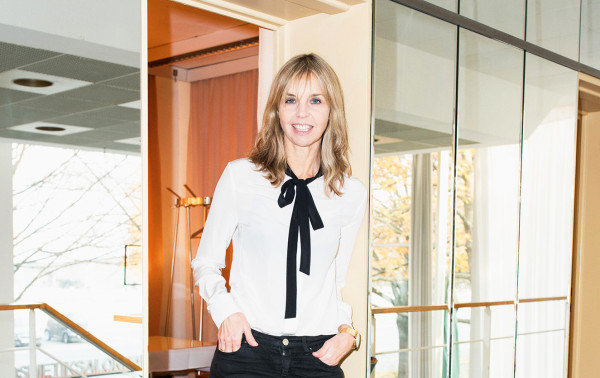
Photo: Christian Werner.
Curbing the magazine's growth is the secret to its success.

Hili Perlson

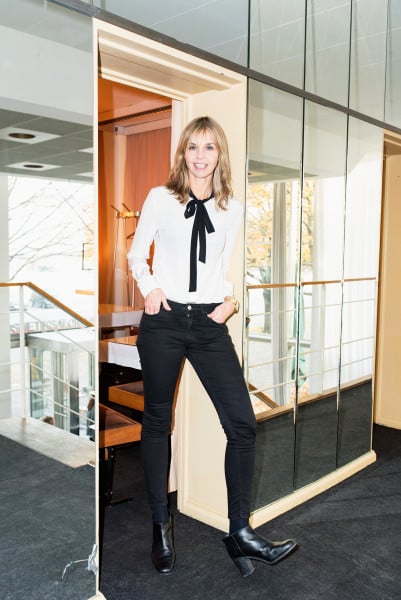
Texte zur Kunst publisher Isabelle Graw.
Photo: Christian Werner.
There’s no arguing the fact that the German publication Texte zur Kunst (TzK), founded in 1990 in Cologne by Stefan Germer and Isabelle Graw, has shaped art criticism in Germany and beyond. What started as a small enterprise run from the heart of the German art underground and read by a close circle of like-minded thinkers, has in the course of 25 years and 100 issues, produced a veritable theoretical canon.
On the occasion of its 25th anniversary, TzK is celebrating, fittingly, with a symposium in Berlin—the magazine’s home since 2000—where artists, thinkers, and critics from different generations will look at the process of canonizing discourses.
artnet News sat down with Isabelle Graw to discuss 25 years in the art and publishing worlds, and what is the secret to survival in both.
You’ve been active in the art world for a quarter of a century. What is the main transformation you’ve observed in the art world in the past 25 years?
In 1990, when we began, artistic production was not as central to the cultural discourse as it is now and it was less associated with money, success, or glamour. I remember when telling friends of my parents at the time that I worked as an art critic, they congratulated me for my “nice hobby”—these activities weren’t considered serious professions yet. Further, the amount of people interested in artistic production was negligible; you basically knew your colleagues and the other agents of this social universe.
By contrast, since 1990 the art world has gone through a structural transformation that led to a shift from a rather small scene, organized as a retail industry, to a corporate global industry governed by the celebrity principle. That’s one of the many changes.
Another major change is that our firm belief in the historical model of institutional critique shifted in so far as we had to acknowledge, after 25 years, that many procedures associated with it are occasionally not only quite welcomed by the institutions, but also lost their epistemological potential. So with a magazine like TzK you have to realize that you’re constantly questioning your premise and everything you took for granted, because what was considered a convincing approach in one situation turns out to be rather questionable under different historical circumstances. But in a way, that’s what the magazine is about. We’re very interested in detecting these changes and questioning our methodological prerogative accordingly.
You’ve discussed how any type of cultural production, including criticism and work in the art that sees itself as detached from the market, serves to produce value. Is that something you take into account when making an issue, that whatever criticism you put out will most likely be metabolized by the market?
I would never opt for such a schematic (and pessimistic) vision. That reminds me of the old “co-optation argument,” which proposes that everything that was once critical will be co-opted at some point. Of course this can be true in certain cases, which would have to be analyzed in detail, but putting it so schematically means overlooking the specific circumstances where criticism can have an effect and does make a difference. While I’d agree that a certain notion of so-called “criticality” is entirely compatible with the “new spirit of capitalism,” I would nevertheless insist that it does matter what kind of arguments you use for and against a practice, how you argue, and in what kind of situation, and that these doubts that criticism can raise do make a difference. It’s not that everything gets neutralized by a totalized market.
Of course, whereas it was once believed that the avant-garde’s breaching of art and life was emancipatory, seen in the light of the new economy this emphasis on “life” looks quite different now. One could say that the historical avant-gardes, by incorporating life-events, delivered a resource that is considered quite valuable in this economy. Think how Facebook markets our “life events.” I think it’s important to understand these shifts, but it doesn’t mean that all attempts to consider the outside of art as its inside are therefore ineffective. One has to be specific and look at a specific practice in its specific historical circumstances in order to understand what is at stake.
Sometimes it’s very hard to understand the merits of a certain artistic proposition and it’s difficult to figure it out, but that’s when it gets interesting—when an artistic practice causes problems or presents itself, as Adorno called it, as a Problemzusammenhang. When I don’t know what the art work is actually about; when it irritates me to a certain degree it often gets me thinking. In other words: It’s more challenging when I can’t measure or even evaluate its effects.

Photo: Ilya Lipkin
That makes me think of the recent discussion around Richard Prince’s use of Instagram images. It seemed like people were irritated by it because the conditions of appropriation have changed, though his practice perhaps didn’t. But was that an interesting discussion?
That discussion is an old one because Prince already faced a lawsuit when he appropriated the picture of Brooke Shields. Appropriation was a very loaded term in the early 1980s, equated with critique and regarded as an emancipatory act of intervention. But was it ever that? First of all, appropriation as an artistic procedure has been entirely normalized by now. There’s no artist today who is not appropriating to a certain degree. It’s just a very standard operation that can hardly be overtaxed as “critique of representation” the way it was in the early 80s. I’d argue that appropriation never only implied a critical relation to what was appropriated. It also implied fascination, an homage, like in Sherrie Levine’s appropriations of Egon Schiele’s drawings, where I also see someone who’s identifying with Schiele, through mimetic rivalry. So I think it’s time to look at appropriation slightly differently, which I tried to do in a book on women artists in the 20th century I wrote years ago, called The Better Half.
Besides the changes in the art world and historical context of practices, the publishing world has also undergone major transformations in the course of 25 years—financial ones especially. How was TzK affected?
We understood ourselves as a kind of quasi-academy that operates differently than the existing art institutions and stands in a conflicted relation to market conditions. As much as we were an agent in the art market from the get go—by producing editions and by selling ads—we also insisted on our right to dissociate ourselves from the agreements that you find in different segments of the market. Admittedly, we operate partially like a gallery when we sell editions—when we choose them we also have commercial criteria in mind. That’s where some of the money that finances this whole project is made, in addition to subscriptions and ads. The artists who generously support us with editions basically allow for their work to be questioned in a theoretically ambitious way. They help maintain the freedom of criticism to criticize them. It’s a slightly perverse arrangement, which is at times hard to keep up, but that’s the idea.
In the beginning, we didn’t theorize our involvement in market conditions—we operated rather intuitively. We also regarded ourselves as a forum that had little engagement with official art history in Germany at the time; our focus was Anglo-American art history—and this has changed a lot, too. Many authors of ours are professors now, so we have to admit that we are part of the institutionalized art history. Some of the methods and artists we favored have become canonized as well, so we seem to even have canonical power. That’s why we’re doing a conference that addresses the canon theme.
Do you think there’s a generation of German artists whose careers gained traction thanks to TzK?
I’d never formulate it quite this way, because there are many factors that go into an artist’s career, but I would say there’s no career without critics and theorists producing symbolic meaning. And producing it in a convincing way that is considered an authority. TzK has played a very central role in the making of many artists, but it certainly wasn’t the only agent that contributed to their institutional recognition.
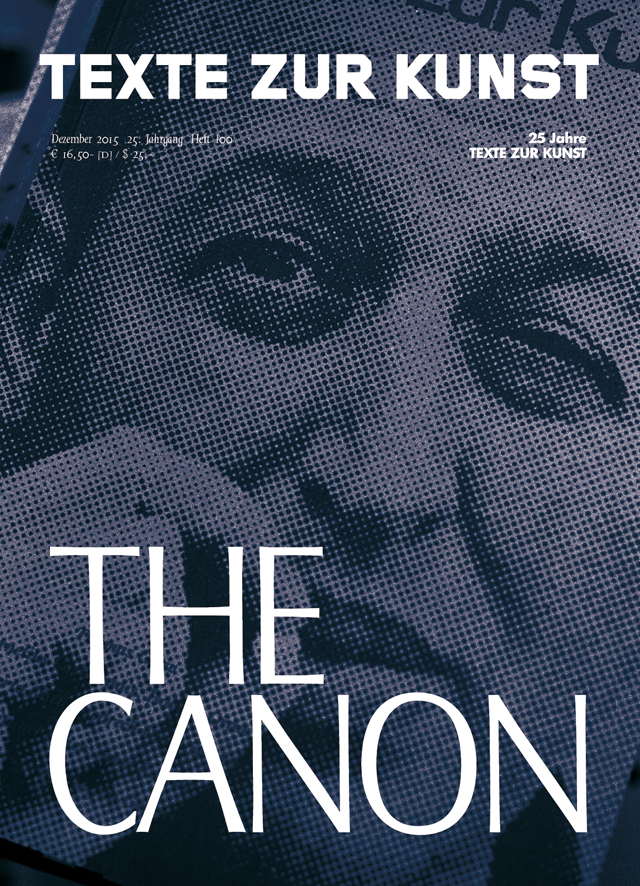
Texte zur Kunst #100 (December 2015).
What was behind the shift from publishing only in German to including English too?
We decided to become bilingual in 2006 but, again, it was an intuitive decision; we wanted to have more direct conversations with our theorists, art historians, and critics friends in the US and UK, since we felt that TzK was shrouded in myth and that it was time to demystify it. But we also wanted our approach to be discussed more globally; as long as we only produced in German we were limiting the amount of people who knew about our propositions.
That’s another thing that changed for us—in the beginning I remember being asked, “So who’s your target group?” and I’d say, “I really don’t believe in this concept.” We’re a group of people interested in a theoretical approach to art informed by critical theory, psychoanalysis, identity politics, and social history and we presuppose—arrogantly—that what we find interesting is interesting for others, too. We really didn’t care. It was a kind of community that needed this publication, and hoped that others would like it as well but we never aimed at a large audience, growth, or economic success. I am happy if this magazine can continue on the same level. Not aiming for expansion of course protects us from certain developments other art magazines had to face. We’re quite independent in our decisions precisely because it’s a small enterprise.
And how about the move to Berlin? Did it become an absolute necessity at some point?
Moving to Berlin meant resetting the way we operated, wrote, situated ourselves, and escaped fixed roles that the art world tends to assign to you. I always joke that even if I did three porn issues (for TzK) in a row and wrote an erotic novel on top of this, people would still say “She’s this dogmatic, Marxist, serious woman.”
Once you’re stereotyped, there’s little you can do, and I think that has to do with a gender bias, too. Moving meant reshuffling all the cards. It allowed us to develop, each on our own in the team, and build up a slightly different identity and social links to other scenes.
When you look at the market now, do you think your book High Price was in some ways prescient?
The dialectic between the art and the market as an opposition that includes each other, a unity of opposites—that’s still valuable when you think about that today.
This dialectic can be detected in the notion of autonomy, developed in the 18th century by writers like Karl Philip Moritz or philosophers like Schlegel and Kant. Autonomy was an ideal, a productive fiction. It was invented at a time when the literary market emerged, when economic pressures started to reach into artistic production. So by insisting on autonomy, these writers tried to protect the freedom of their practice. In retrospect though, the ideal of the autonomous artwork also prepared the ground for its marketing—since the artwork wasn’t tied to the requests of the guilds or courts anymore. This allowed for those transactions and mobility which are crucial for its marketing. So autonomy was Janus-faced already in the 18th century: Providing a certain degree of independence, while allowing for the better marketing of artworks. These kind of paradoxes still hold up. I didn’t foresee what was coming; all the mechanisms were already in place. Those haven’t changed, just the amount of money and people involved has intensified.
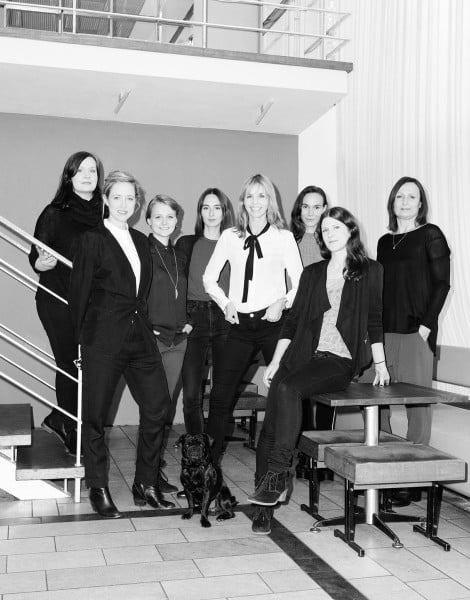
TzK editorial team (from left): Susann Kowal, Caroline Busta, Gwendolyn Detroy, Elena Cheprakova, Isabelle Graw, Laura Schusinski, Hanna Magauer, Sabine Offenbach.
Photo: Christian Werner
TzK produces fashion issues occasionally, and you’ve spoken about the relationship between art and fashion often. Do you see parallels between the way the art market blew up and how the fashion industry became controlled by conglomerates?
I have written about the structural affinities between the changes in the fashion world—increasingly dominated by large corporations since the 1980s—and the art world, which got restructured in a similar way, in my book High Price. There are many structural and personal overlaps between these two social universes to be observed. But there is another current interesting parallel—and we’ll do a fashion issue next June where we’ll discuss that: Similarly to art world insiders, who are not that interested in closely following every exhibition at Gagosian or Hauser & Wirth anymore because these aren’t places you look at with curiosity, the same goes for big fashion brands.
I find that Hedi Slimane is in some sense very smart, in that he produces “Topshop” for the rich with Saint Laurent, but it’s not something I follow that closely anymore. Meanwhile, there have been a lot of younger fashion houses, like Eckhaus Latta, which have reawaken many people’s interest in fashion. But of course, the corporate fashion world takes note of these new developments and reacts to them as much as younger fashion is not outside corporate fashion and negotiates it as well. That’s an interesting parallel where, again, fashion led the way.
How often do you come out with fashion issues? Whenever you recognize instances where as you say, “fashion leads the way”?
Very irregularly, when we feel we have something to say.
I’d also like to interview Natalie Massenet, who founded net-a-porter.com [who resigned in September ahead of the company’s merger with yoox.com], or Hedi Slimane. He rarely gives interviews. But there’s something genius about how he detects the common desire of wealthy women. He has an intuition for what they want. It’s not interesting as fashion, but rather as a strategy. And then he has this slightly clichéd way of understanding himself as an artist which is of course embarrassing, but it would be interesting to confront him with that. I think that his cloths are symptomatic for the current Zeitgeist, a mentality that’s not interested in experimentation and aims for safe bets and clothes that keep the existential fear away.
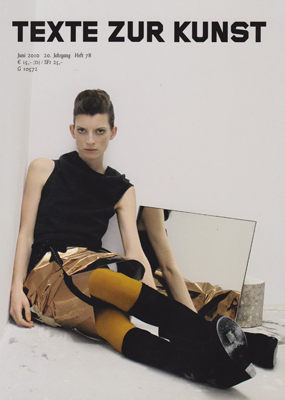
Issue 78 is one of TzK‘s sold out fashion issues.
Do you think this Zeitgeist expands to the art market as well? Is everyone playing it safe?
Due to the current economic and political conditions there is an atmosphere of (often covered up) fear in the art world as well. I sense it at the Städelschule, where I teach—the pressure to succeed has intensified. Even in the 1990s it was possible to hang out in a community and forget these economic conditions for a while, but it’s hard to forget about them now. Think of the “New Theater,” for example, a formation that from the get go targeted the market’s desire for a bohemian fantasy. It thematized the economic pressures this scene was exposed to, and now they’re performing at the Whitney. I find it interesting how market-aware this project was and how it managed to preserve a sense of community and valuable exchange under these circumstances. They’re obviously also having fun and create a social intensity all the same. Having the cake and eating it, too.
Does it have to do with the professionalization of being an artist, or are we seeing the middle-classifization of the art?
Art as a profession might decrease again in popularity, I don’t know when, but it goes in cycles. I think there’s a high awareness to the fact that not everyone can hit the jackpot, though the industry has grown, and jobs in the art world have proliferated as well. Yet, the degree to which students with working class background have entered the Städelschule has certainly decreased since I started teaching there in 2000. Today I encounter less kids from the area of Frankfurt and more hipsters from New York. I’m not saying they’re all rich kids now, not at all! But that’s a specificity of the Städelschule and has to do with its profile, popularity, and the fact that we teach in English now. The Städel has changed a lot, maybe similarly to TzK.